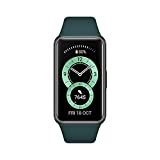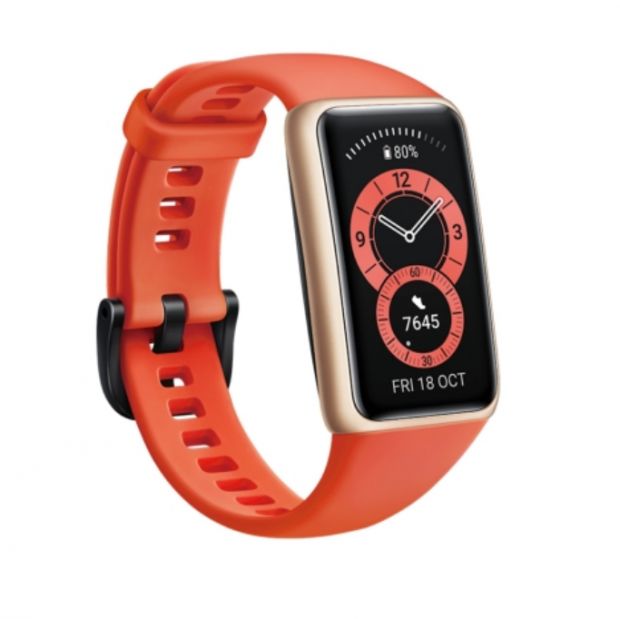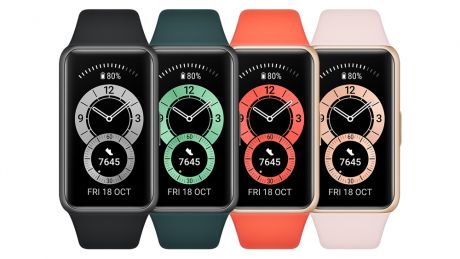Our Verdict
Remarkably similar to the cheaper Honor Band 6, this is a good-looking fitness band that suffers from GPS tracking issues with Android phones.
For
- Excellent battery life
- Looks great
- Superb sleep tracking
Against
- Costs £15 more than the near-identical Honor Band 6
- Same Android woes as the Honor Band 6
- Fiddly to operate while exercising
You can trust Coach

£39.99
Buy from Huawei | £60
Huawei Band 6 In-Depth
Design Of The Huawei Band 6
The Huawei Band 6 and Honor Band 6 really are peas from the same pod. Side by side the only differences are that the Honor version has a red line on the button and “HONOR” embossed on one side. It’s no bad thing, though, because the design is a stand-out in this price bracket.
Its appeal is in its deviation from the long, narrow design of most bands, because Huawei has opted for something slightly wider. Picture a squashed Apple Watch and you’re halfway there. The 1.47in (37mm) AMOLED, 194x368 screen is sharp, if tricky to read in bright sunshine, and the extra space means you feel less clumsy when trying to navigate it. It still can be fiddly, but it’s a noticeable improvement on more traditional 1.1in (28mm) fitness trackers like the Samsung Galaxy Fit 2 and Amazfit Band 5.
The large button on the right-hand side also means you’re not completely reliant on touch controls for things like stopping your workout – handy if the screen or your finger is covered in sweat.
There are plenty of watch faces to choose from, but the proprietary strap mechanism is awkward and means you’re stuck with Huawei’s straps (and Honor’s, I suppose).
Health And Fitness Tracking On The Huawei Band 6
There’s an elephant in the room we’ll point out first. The Huawei Band 6 has a connected GPS feature for more accurate distance tracking outdoors, piggybacking on your smartphone’s signal. You should be able to start an activity using connected GPS from your watch, but you can’t if you’re using an Android phone (with the exception of Honor or Huawei phones which use the EMUI flavour of Android). Instead GPS has to be activated on the Huawei Health app on your phone and the data will display on the Huawei Band’s screen. No other band with connected GPS requires you to start an activity on your phone, so it’s a major reason to avoid the Band 6 (the issue affects Honor as well as Huawei and we’ve confirmed with representatives of both brands that the issue exists).
When connected GPS works, it can work very well. When I used an old review Honor handset I had lying around, it found a signal instantly – faster than the Garmin Forerunner 245 on my other wrist. Using the Honor handset’s GPS signal, the distance tracked was within 0.02km of the dedicated GPS chip in the Garmin. Notably, however, when manually paired with my Samsung S10e via the app, GPS was significantly off, measuring 5km as 4.76km and 4.77km in two different cities. That’s the problem with connected GPS – you’re at the mercy of another product.
The Huawei Band 6 is also a little fiddly to interact with while running. You have to scroll down using the touchscreen to read all your stats, which isn’t ideal when exercising. As far as I can tell there’s no way to customise the order things appear in, either, meaning you can’t guarantee the stats which are important to you will be at the top for you to glance at.

Compared with the Honor Band 6, there are two notable additions. Firstly, Huawei offers all-day SpO2 tracking, while the Honor Band 6 only allows for spot checks. An accurate SpO2 reading tells you how much oxygen is in the blood, which can be useful for spotting conditions like sleep apnoea, as well as telling you how you’re recovering or acclimatising to high altitudes. (In clinical settings a pulse oximeter worn on the finger can also be used to detect health deterioration from COVID-19 at an earlier stage.) Still, given the patchy reliability of SpO2 readings from the wrist, I’d question whether this is worth the extra money.
The second improvement also sounds promising but is similarly underwhelming in practice. While the Honor Band 6 has only 10 trackable exercise types, the Huawei Band 6 has 96. However, for all the extras – from laser tag to bungee jumping – it does the same thing, measuring heart rate to estimate a calorie burn. You’d be just as well served selecting “other” on the Honor Band and saving £15.
Like the Honor device, the Huawei Band 6 has great sleep tracking, which not only breaks down your night’s sleep into deep, light and REM sleep, but also offers useful guidance on improving your shut-eye rather than just giving you the stats and leaving you to figure it out. Similarly, the breathing exercises feature – where a yin and yang symbol expands and contracts on screen to guide your inhalations and exhalations – is a welcome break from a particularly stressful day.
Living With The Huawei Band 6
The Huawei Band 6’s battery life is extraordinary for a wearable with a colourful AMOLED screen. Huawei says it is 14 days with typical use, dropping to 10 if you frequently use features like connected GPS, continuous heart rate monitoring and TruSleep.
That rang true for me, and it’s amazing how much it can eke out when under pressure. I noticed the battery was at 3% at 9.30am and kept checking throughout the day expecting it to have given up the ghost, but it was still chugging along when I turned in that night. It didn’t make it until the morning, but it’s hard not to be impressed by its staying power.
Just as pleasingly, you don’t have to wait long for it to top up from empty, either. The magnetic fast charger will give you up to three days’ use from a 10-minute charge.
The smart functionality stacks up well against the competition. There are easy-to-read notifications and a weather app, as well as the ability to turn the screen into a torch. On some phones, the device can also act as a remote control for your phone’s camera and music player.
See related
- Best Cheap Fitness Trackers
- The Best Fitness Tracker Deals: Cyber Monday 2021 Has Arrived
- The Best Fitness Trackers Of 2021
Should You Buy Something Else?
Given the identical look and feel, iPhone users would be better off saving £15 and going with the Honor Band 6. Yes, the Huawei Band 6 has a couple of extra features, but they don’t add an awful lot. Including nearly 10 times as many exercise types isn’t compelling when the additional options all offer the same basic generic measurements. All-day SpO2 readings are also not a dealbreaker, given the lack of accuracy for wrist-based readers.
If you own an Android phone, we’d recommend the bargain Xiaomi Mi Band 6, an even cheaper band without the connected GPS issues and a smart new way of tracking your activity.
Alan is a freelance tech journalist and mostly covers fitness trackers for Coach.
Alan was not what you would call a big fitness guy growing up, but has been radicalised by parkrun and taken up running in a big way. Although nowhere near podium at races, as a late starter he does at least know that he can still get faster. Alan has written for ShortList, Tom’s Guide, Trusted Reviews and Expert Reviews, among others.


